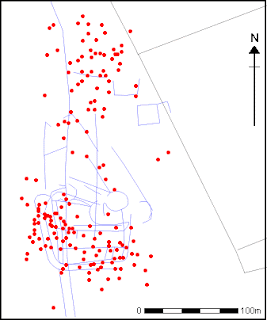6.6: Surface Survey with Metal Detectors
The metal detector is of course an effective survey tool that can be used alongside several other techniques. This section of the text will expand on the previous ones and illustrate some results of surface investigations involving the use of metal detectors.
The first example of good practice that I will use here is an old one, from the early days of archaeological collaboration with hobbyist metal detectorists, the survey of the site at Cottam B (Anglian and Anglo-Scandinavian Cottam: linking digital publication and archive). The first picture shows the distribution of surface finds in a field overlaid on a simplified plan of the cropmarks:
 |
| Cottam B (Internet archaeology) |
In the following plots we see the plots of scatters of individual types of metal objects (the non-metallic material was not collected in this project) and it can be seen that there are relations between them which may be analysed, and if we were to plot other material, slag and other manufacturing debris, pottery of different fabrics, burnt daub etc, then this gives us a basis for interpretations of zonation and maybe chronology of various events on the site. This is all evidence lost if the material is not plotted accurately.
 |
| Cottam B (Internet archaeology) |
 |
| Metal detector survey results compared with results of geophysical survey (Keith Westcott, Institute of Detectorists) |
The two following figures come from the webpage on systematic metal detector survey of Earthsound Archaeological Geophysics from Ireland. The first shows a raw plot of finds, they are zoned, with areas of dense concentrations and 'blank' zones. This pattern may be analysed and determinations made of whether this represents a difference due to differential landuse in the past, or whether this is an indication of the state of preservation of the site.
 |
| Detector survey results (Earthsound) |
 |
| Survey results (Earthsound) |
The next example is from the webpage of MAP Archaeological practice, and shows the results of a systematic (gridded) metal detecting survey near Malton. The orange outlines are old evaluation trenches, the shaded area unsurveyed. Again the distribution of material across the field is differentiated, with two linear patterns visible. Here also the metal distribution is shown without reference to that of other material.
 |
| Detector survey results (Malton Archaeological Practice) |
 |
| (from work by Battlefield Restoration & Archaeological Volunteer Organization - BRAVO) |
Quite clearly, even though these objects are found in the ploughsoil, their horizontal position and relationship to other objects (and information) comprises their archaeological context. Removal of the item from the ground without carefully noting the position and precise associations destroys that context.
The final, for now, example comes from a metal detector survey of a different type, Polish archaeologists searching the April 10th crash site of the Polish Presidential Tupolev by Smolensk airport. The report is restricted, so I am not going to show the actual metal detector survey results here. This plan produced by amateur investigators of the disaster (and there are many) will suffice for discussion.
 |
| Fragment which was not buried by the impact (Smolensk April 10th 2010) |
 |
| Scatter of debris (Polityka edited from satellite photos) |
The plane broke up as it crashed through a forest and bits of it went flying in all directions. The distribution of the burnt fragments about which so much had been made in the right-wing press was shown by the archaeological investigations to have been quite specific. The interpretation of their distribution was that as the plane fragmented, some of the smaller fragments from the parts of the plane that hit the trees and ground first were sucked into the jet engines which were at the moment of impact still working on full throttle and thrown out behind them. The context of those fragments comprises their horizontal distribution and associations and relationship with every other fragment in that scatter - and it is only from that the interpretation can be reached, a handful of loose burnt fragments from the scatter as a whole tells us nothing, and can lead (as it has) to completely unjustified conclusions.
This text was adapted from my blog post PACHI Thursday, 6 March 2014, 'Focus on UK Metal Detecting: More on What's this all about?'.
Tamara Kroftova comments:
"The examples shown above go back to 1990, so have been known for thirty years, and yet there have been so few emulators in the British artefact hunting community. Why is that? Why have artefact hunters come to see themselves as "heritage heroes" for presenting just a few loose finds they have hoiked from teh ground at an 'x-marks the spot' findspot instead of for bringing the carefully compiled archive of a systematic search project. As Sutherland points out (p 944), in a period when so much is being thoughtlessly and irresponsibly stripped away during collection-driven exploitation of the archaeological record, work on the archaeology of surface sites in Britain is: “a race against time with the metal detector as both saviour and sinner". A process in which there are so few "saviours" and thousands of "sinners". The situation in Britain today is just wanton destruction".




Comments
Post a Comment